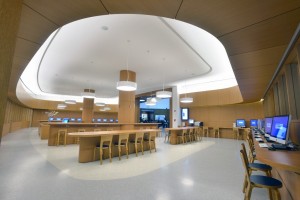Michael Randazzo for the Brooklyn Heights Blog: Please discuss your tenure at BPL and highlight significant accomplishments.
Linda Johnson, BPL: I came to the [Brooklyn Public] Library after some shaky leadership issues that polarized the Library. There were two things I noticed. The first is that the Library wasn’t really thinking strategically about where we were going. It very much is a business in transition. As people start to read digitally, it’s changing the way we get our information and …the way we access information and knowledge, and it’s important to be mindful of that, and not just to let it happen. I’ve done a lot to stress the importance of thinking about what we do in a very strategic fashion. And the other thing that was immediately apparent to me, because I started visiting the branches right away, was that every branch was doing the same thing. The fact is that we’ve got a presence in every Brooklyn neighborhood and they’re all very different. A great library is a library that fulfills a need in a particular community, and so what we’re trying to do—we’ve done a strategic plan—…we’ve really started to look at how we can best deliver service in every part of the borough. That doesn’t mean delivering the same service in every part of the borough, it means really addressing the needs of particular communities.
I’m proud of the fact that we’re now embracing new technologies, we’re now lending tablets, we’re lending laptops, so we’re really moving the needle forward because so many of our households are on the wrong side of the digital divide. That expression—the “digital divide”— is such a cliché, but it’s a really bad thing to be on the wrong side of the digital divide. It’s really not where you want to be, because it affects your ability to do everything, from applying to jobs to pretty significant health care issues.
 We opened the information commons [the Shelby White and Leon Levy Information Commons] a little over a year ago, which is an extraordinary place in the Central Library. We did that with private money from the Shelby White and Leon Levy Foundation, and we’re really helping people learn how to use technology to work better. In that space—and it’s been pretty beat up in the Central Library—when you go there you’ll see that there are public access computers, there are stations where people can hook up their own devices, there are staff people who are able to help you with technology, not just in the sense of just cruising around on the Web but to access complicated databases that would be too expensive for people to have in their homes. There’s a recording studio in there, and there are rooms where people can work collaboratively—that’s sort of a new thing relatively speaking overall in libraries; remember that people used to go off and work by themselves. There’s also a big training lab. We’ve started to partner with other non-profits in the community and offering spaces to them to offer classes to our patrons. So, we’re doing a lot of work with BRIC in that particular area right now.
We opened the information commons [the Shelby White and Leon Levy Information Commons] a little over a year ago, which is an extraordinary place in the Central Library. We did that with private money from the Shelby White and Leon Levy Foundation, and we’re really helping people learn how to use technology to work better. In that space—and it’s been pretty beat up in the Central Library—when you go there you’ll see that there are public access computers, there are stations where people can hook up their own devices, there are staff people who are able to help you with technology, not just in the sense of just cruising around on the Web but to access complicated databases that would be too expensive for people to have in their homes. There’s a recording studio in there, and there are rooms where people can work collaboratively—that’s sort of a new thing relatively speaking overall in libraries; remember that people used to go off and work by themselves. There’s also a big training lab. We’ve started to partner with other non-profits in the community and offering spaces to them to offer classes to our patrons. So, we’re doing a lot of work with BRIC in that particular area right now.
I really feel like it’s been a home run, and at the end of the day the greatest accomplishment is really about the program and about how we’re helping people, first and foremost. It’s been great. It’s an amazing set of communities, and it’s an organization that’s positioned in a way that can help certain members of the community that might not get help otherwise. We don’t care who you are; all you need to do is come in and have the sort of imagination and inclination to cross our portal and we’re there for you.
Read more:
